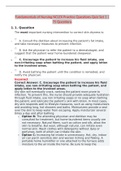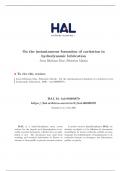Tentamen (uitwerkingen)
ERHS 502 fundamentals of toxicology final exam questions & answers 2024
- Vak
- Instelling
ERHS 502 fundamentals of toxicology final exam questions & answers 2024 thalidomide (use, MOA, effect) - ANSWERSused to treat morning sickness creates oxidising (low GSH) environment that suppresses transcription factor NF-KB that you need to turn on genes for growth (not able to reduce S-S...
[Meer zien]













